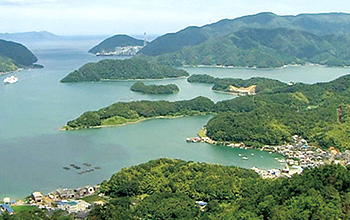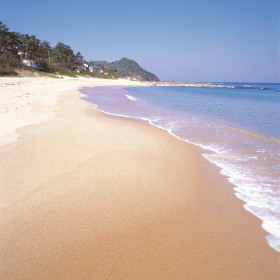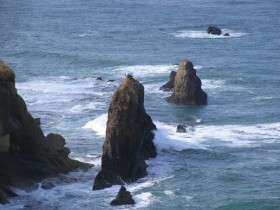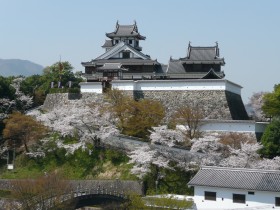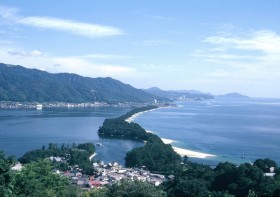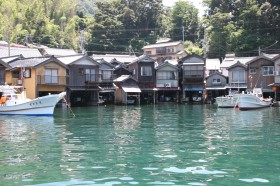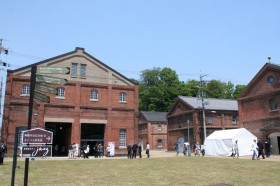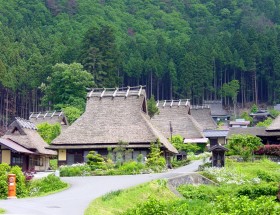Sightseeing Information
Kotohiki-hama (The Singing Sand Beach)
Kotohiki-hama Beach is a 1.8km long white sandy beach with green pine trees. The beach is famous for the peculiar sound its sands make; if you walk on the beach by scuffing your feet on the sand, the sand makes a squeaking sound said to be similar to the sound of the koto, a kind of Japanese harp. The beach takes its name from koto, hiki, meaning “to play”, and hama, meaning “beach”. A certain area of the beach is also known as the Taiko-hama, as the sands give off drum-like sounds when scuffed (from taiko, meaning “drum”). The sands do not make a sound when they are dirty however, so local people cooperate to keep the beach pristine. The beach is relatively close to the Byobu-iwa (Folding Screen Rock); 10 km away, taking about 20 minutes by car.
- Address
- 629-3112
Amino-cho Kakezu, Kyotango City, Kyoto Prefecture - Access
- About 75 minutes
- Distance
- About 60km (from Port of Kyoto)
- Links
-
Kyotango City Tourism Association
- Contact
-
Amino-cho Branch, Kyotango City Tourism Association
TEL +81-772-72-0900 (Japanese language only)
Byobu-iwa (Folding Screen Rock)
This 13m andesite rock is named for its appearance, as it is said to resemble a folding screen (byobu) rising steeply from the sea. This peculiar sight is known as a geosite in the San’in Kaigan Geopark. There is an observation deck at the coastal terrace on the other side of the coast which gives great views of the rock. The area is located 10 km away, 20 minutes by car, from the Kotohiki-hama Beach, which is famous for its "singing" sands.
- Address
- 627-0222
Tango-cho Fudeshi, Kyotango City, Kyoto Prefecture - Access
- About 80 minutes
- Distance
- About 60km (from Port of Kyoto)
- Links
-
Kyotango City Tourism Association
- Contact
-
Tango-cho Branch, Kyotango City Tourism Association
TEL +81-772-75-0437 (Japanese language only)
Fukuchiyama Castle
Fukuchiyama Castle was established in 1579 by Akechi Mitsuhide, a general who suppressed the Tamba area. It was demolished in the early Meiji Era (1868 – 1912), and only the stone walls and the Akaganemon Guard Station were left. In 1986 however, the 4-storied-3-floored castle keep was rebuilt due to strong enthusiasm from the local people. The inside of the castle is open as a local museum to show materials related to the castle and the historical and cultural assets in Fukuchiyama. You can enjoy great bird’s-eye views from the tower, including views over the Yura River and the Fukuchiyama valley.
- Address
- 620-0035
5 Naiki, Fukuchiyama City, Kyoto Prefecture - Access
- About 40 minutes
- Distance
- About 36km (from Port of Kyoto)
- Links
-
Fukuchiyama Tourist Association
- Contact
-
Fukuchiyama Castle (Local museum)
TEL +81-773-23-9564 (Japanese language only)
Amanohashidate (Bridge to the Heavens)
One of the Three Scenic Views of Japan
Amanohashidate, along with Matsushima and Miyajima, ranks as one of the three most scenic views in Japan, and has been designated a place of special scenic beauty by the national government. A sandbar stretching about 3.6 km, along which grows some 8,000 pine trees, is often compared to a bridge connecting Heaven and Earth. The monument erected there in July 7, 2006, inscribed with poems composed by Yosano Hiroshi and Akiko, is a must-see for visitors enjoying a strolling along Amanohashidate.
Amanohashidate, along with Matsushima and Miyajima, ranks as one of the three most scenic views in Japan, and has been designated a place of special scenic beauty by the national government. A sandbar stretching about 3.6 km, along which grows some 8,000 pine trees, is often compared to a bridge connecting Heaven and Earth. The monument erected there in July 7, 2006, inscribed with poems composed by Yosano Hiroshi and Akiko, is a must-see for visitors enjoying a strolling along Amanohashidate.
- Address
- 626-0001
Amanohashidate Monju, Miyazu City, Kyoto - Access
- About 50 minutes
- Distance
- About 40km
- Links
-
Amanohashidate Tourism Association
- Contact
-
Amanohashidate Tourist Information Center
TEL +81-772-22-8030
Funaya Boat houses of Ine
Picturesque scenery with numerous boathouses lining the shore
The lower floor of these funaya boathouses is for boat mooring and the upper floor is the living area. There are around 230 of these funaya and they are situated in neat rows like a grid that surrounds Ine Bay. At the Ineura inlet, you can see this unique scenery and the lives of people who coexist with the sea. In July 2005, Ine Town became the first fishing settlement to be designated as an Important Preservation District for Groups of Traditional Buildings.
The lower floor of these funaya boathouses is for boat mooring and the upper floor is the living area. There are around 230 of these funaya and they are situated in neat rows like a grid that surrounds Ine Bay. At the Ineura inlet, you can see this unique scenery and the lives of people who coexist with the sea. In July 2005, Ine Town became the first fishing settlement to be designated as an Important Preservation District for Groups of Traditional Buildings.
- Address
- Kameshima, Hirata, Hide, Ine Town, Yosa-gun, Kyoto
- Access
- 90 minutes by car
- Distance
- About 65km
- Links
-
Ine Town Tourism Association
- Contact
-
Ine Town Tourism Association
TEL +81-772-32-0277
World Cultural Heritages: Historic Monuments of Ancient Kyoto
World Heritage sites are a testament to what we have managed to retain from the past. The Historic Monuments of Ancient Kyoto consists of 17 temples, shrines and a castle, including Toji Temple, Kiyomizu-dera Temple and Nijo Castle as well as Enryakuji Temple, situated atop Mt. Hiei in Otsu City, Shiga Prefecture. The mission for the current generation is to ensure that these cultural heritage sites are preserved for future generations.
- Address
- Kyoto city/Uji City
- Access
- 90 minutes
- Distance
- About 100km
- Links
-
World Cultural Heritage -Historic Monuments of Ancient Kyoto-
- Contact
-
KYOTO PREFECTURE TOURISM GUIDE
TEL +81-75-411-9990
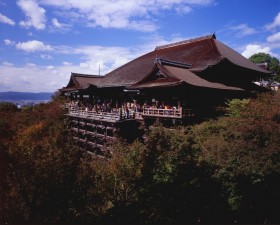
Maizuru Brick Park
Visit the foundation of modern Japan
These red brick warehouses, established at the beginning of the 20th century, laid the foundation of modern Japan, and still remain in the Kitasui area. In May 2012, they were renovated and opened to the public as Maizuru Akarenga Park. The park is used as a place of entertainment and relaxation, a venue for art, and a sightseeing spot.
These red brick warehouses, established at the beginning of the 20th century, laid the foundation of modern Japan, and still remain in the Kitasui area. In May 2012, they were renovated and opened to the public as Maizuru Akarenga Park. The park is used as a place of entertainment and relaxation, a venue for art, and a sightseeing spot.
- Address
- 625-0080
2-1039 Kitasui Maizuru City - Access
- 20 minutes by car
- Distance
- 8km
- Links
-
Maizuru Brick Park
- Contact
-
Maizuru Tourism Association
TEL +81-773-75-8600
Miyama Kayabuki no Sato (Thatched-Roof Village)
Experience a fascinating village comprised of thatched-roof houses
There are many kayabuki thatched roof houses in Miyama Town: 38 out of the 50 houses in the community of Kita in Chii district, have traditional thatched roofs. There is widespread admiration for the dedication of Miyama Town to preserve these historical neighborhoods including a group of buildings made by traditional techniques. In December 1993, Miyama Town was designated as an Important Preservation District for Groups of Traditional Buildings.
There are many kayabuki thatched roof houses in Miyama Town: 38 out of the 50 houses in the community of Kita in Chii district, have traditional thatched roofs. There is widespread admiration for the dedication of Miyama Town to preserve these historical neighborhoods including a group of buildings made by traditional techniques. In December 1993, Miyama Town was designated as an Important Preservation District for Groups of Traditional Buildings.
- Address
- 601-0712
Miyama Town, Nantan City, Kyoto - Access
- 90minutes by car
- Distance
- 72km
- Links
-
Kyoto Miyama Navi
- Contact
-
Miyama Town Tourism Association



